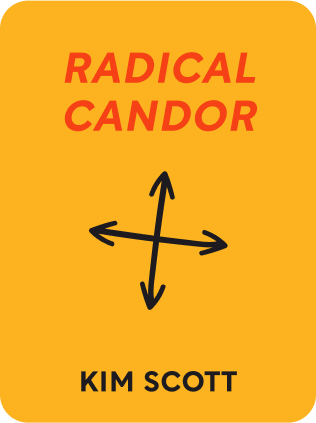

This article is an excerpt from the Shortform book guide to "Radical Candor" by Kim Scott. Shortform has the world's best summaries and analyses of books you should be reading.
Like this article? Sign up for a free trial here .
What is radical communication? How can meetings support the communication needs of a culture of radical candor?
Radical communication is the effective communication that comes with building and maintaining a culture of radical candor. Part of it is having the right meetings at the rights times for the right reasons.
Read on to better understand what radical communication is and the meetings you need to support it.
Meetings for Radical Communication
If you’ve built a radically candid team that can listen to one another’s ideas, work toward common goals in debate, and make good decisions, your main job during the collaborative process should be maintaining effective communication. There are three areas in which focusing on communication is vital: the meetings that happen throughout the collaborative process, the learning and shared information around execution, and the messages you’re sending about culture.
There are six types of meetings that should happen over the course of the collaborative decision-making process: one-on-one meetings, your staff meetings, reflection, debates, decisions, and all-hands meetings.
One-on-One Meetings
In one-on-one meetings with employees, you should demonstrate personal care by getting to know them better, figure out what’s going well and what’s not, and help clarify their ideas. For these meetings, your employee should set the agenda, so they have the opportunity to discuss what’s really important to them.
There are several ways to help guide these conversations in a productive direction:
- You can lay out basic guidelines—for example, would you prefer that your employee come with a structured agenda, or are you more interested in having a “what’s on your mind” chat? If you’d like them to write up their agenda in a shared document that you can both look at, let them know.
- Be ready with questions that reveal the gaps between what the employee is doing, thinks she should be doing, and wants to do. Some helpful questions include, “Is there something you’re not working on that you’d like to? Why not?” or “What can I do to help you do more work that you want to do?”
- Help them clarify their ideas for debate by demonstrating how their audience will experience the idea. This might look like, “I don’t think the engineers on the team will understand this choice. Can you explain it again, in a way that might be clearer for them?”
These meetings create vital conversations—both for getting to know your employee and for refining ideas for the next steps of collaboration—so do not think of them as low-priority and reschedulable.
Your Staff Meetings Are Opportunities for Radical Communication
A well-run weekly staff meeting can get everyone up to speed on shared priorities. This meeting should have three goals for radical communication: review the previous week’s work, share updates, and outline what needs to be done in the coming week.
- Review: Have a visual of key metrics (such as activities and results) from the previous week—spend 20 minutes looking at the numbers together and determine if you are on track toward your goals.
- Share updates: Share important information that isn’t included in the metrics, such as “I’m going to be off for two weeks next month,” or “Katie just informed me that she’ll be leaving my team in 3 weeks.” Have everyone spend a few minutes reading a shared document of updates. Keep this process efficient by prohibiting side conversations—any follow-up questions or comments should happen outside the meeting.
- Outline the coming week: Based on the information you’ve gathered from the key metrics and updates, your team can then spend 30 minutes clarifying two big decisions and one big debate that need to happen in the next week. Assign these topics to “debate” or “decision” meetings and assign a leader for each meeting. This ensures that you don’t have to take on responsibility for the meetings. Remember to communicate the agendas for these meetings to the entire team (not just yours), so that they have the opportunity to attend if they want to.
Reflection
Among all your work, you need to be sure that there’s time to clarify your own thoughts and reflect on how you can help your team members. Schedule time for reflection into your calendar (a few hours a week, at least) and be firm that nothing can be scheduled during that time. Your team members should do the same.
Debates Are Part of Radical Communication
Debate meetings are for debate only, not decisions. Keeping your debate and decision meetings separate reduces the friction between those who want to get to a decision ASAP and those who want to continue talking about an issue. Again, anyone should be able to attend these meetings if they want to. The only people required to be in these meetings are those identified during your staff meeting.
The outcome of a debate meeting should be a full understanding of the issue at hand, clarification on what needs to happen moving forward, and a consensus on if more debate is needed or if it’s time to make a decision
Decisions
A dedicated decision meeting is important because it signals clearly that it’s time to stop debating and start deciding. As with debate meetings, decision meetings should be open to anyone who wishes to attend—but the decision-makers in these meetings should only be those who are closest to the facts and thus have the information to make the best possible decision.
The outcome of a decision meeting should be a meeting summary that’s sent out to relevant people to explain the decision, and a decision that can’t be appealed or debated. A decision that can be easily taken back or changed is meaningless. Remember that you aren’t the decision-maker in these meetings. If you have a very strong opinion about the subject, you can attend the meeting and give your input, or declare veto power—but this should be used sparingly.
All-Hands Meeting
The purpose of the all-hands meeting is to persuade the people outside your team that the right decision was made—if you make decisions without sharing, people tend to think you’ve done something sneaky or exclusive. These meetings aren’t important for a small team where everyone is usually well informed about changes and decisions, but they are important for very large teams with more than 100 people. All-hands meetings should have two parts: a presentation and a Q&A session.
The presentations are usually done by the decision-makers and should include one or two reasons this decision is important or exciting, as the goal is to get everyone informed and on board. The follow-up Q&A session should usually be led by higher-ups such as the CEO or team leaders. Their role is to learn what their employees are really thinking or concerned about, and to answer challenging questions in a persuasive manner.
Radical Communication Includes Execution and Learning
There are several steps you can take to ensure that your team is sharing information throughout the execution of their ideas, and to keep your lines of communication open so you can continue to learn about your organization at all levels.
Schedule Time for No Meetings
The collaborative process requires a lot of meetings, and it’s important to take some time off from them—when you have too many meetings, there’s no time to execute on the decisions that have been made. Schedule dedicated time for execution into your calendar every week, and ask your team members to do the same. Commit yourself to this calendar event as you would any other meeting.
Make Accountability Visible
When working toward a goal together, it’s important that teammates are able to visualize their own workflows within the larger context of the team’s. Making workflows visible to everyone accomplishes three main goals.
Visible workflows allow your team to easily identify issues, delays, and other problems early. They can fix these issues on their own, before they get so large that management needs to step in.
Visible workflows reveal who’s putting in the work to get good results, and who is coasting on the success of their team. This information is equally important when things are going well, and you want to know who deserves the most recognition, and when things are going poorly, and you want to know who you can rely on to get the team out of a sticky situation. Additionally, this information naturally leads to promotions, stellar performance reviews, and recognition where they’re really deserved.
Visible workflows illustrate what activities or work are creating success and where focus or priorities should be shifted. For example, the Google AdSense team hired salespeople to make cold calls to large websites. However, before the sales team could get underway with cold calling, orders from smaller sites started pouring in. Since the orders were easier to deal with than calls, the sales team started focusing almost exclusively on them. There was a lot of money coming in, but it wasn’t because the sales team was successful—after all, they were only processing orders, not selling. Once the AdSense team started measuring activities and realized that their salespeople were almost exclusively doing work they weren’t hired for, they were able to redirect them back to making cold calls and added a support team for processing orders. As a result, the sales team could use their skills to land much bigger sites and bring in significantly more revenue, and AdSense could continue benefiting from the smaller orders.
An easy workflow visualization system you can set up is the Kanban system. It involves putting up a board with three columns—to do, in progress, and completed. Assign each of your team members a different color and give them sticky notes in that color. Team members will write their tasks on their sticky notes and move them between columns as they work through their tasks.
Keep an Ear to the Ground
As the boss, you’re naturally busy—with meetings, travel, your own work, giving guidance, and so on—and it’s not possible to squeeze in meetings with everyone in your organization. Nevertheless, it’s important that you get to know people at all levels of your organization and keep tabs on what’s happening. Do this by scheduling time to simply walk around, and make an effort to accomplish three things during your walk:
- Notice problems or successes you don’t see while caught up in your routine or in other priorities
- Talk to people you haven’t spoken to in a long time, and ask about their current projects
- Find small problems and take care of them right away, such as washing out the cups piled up in a coffee nook. This helps you stamp out issues before they become a huge problem, effectively discourages the mentality that any job can be “beneath” someone else, and shows your team that you truly care about them and their smaller issues, which inspires them to care about smaller issues.

———End of Preview———
Like what you just read? Read the rest of the world's best book summary and analysis of Kim Scott's "Radical Candor" at Shortform .
Here's what you'll find in our full Radical Candor summary :
- How you have to be direct with people while also caring sincerely for them
- Why relationships are an essential part of successful leadership
- How to create a strong team culture that delivers better results






